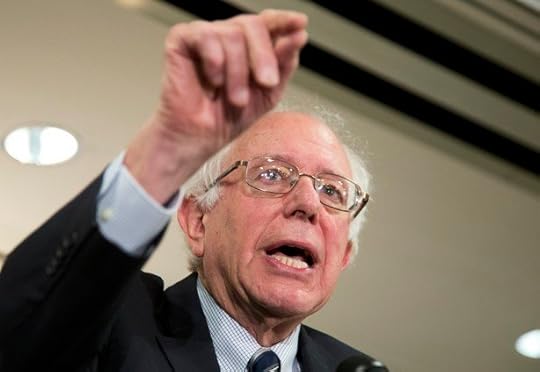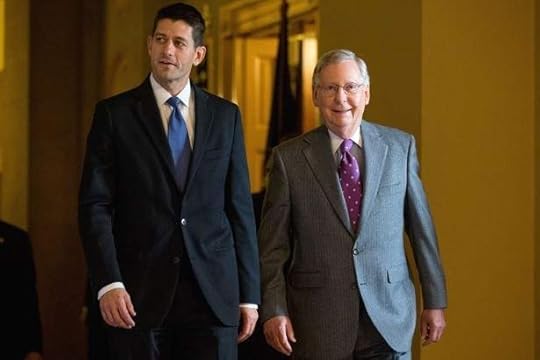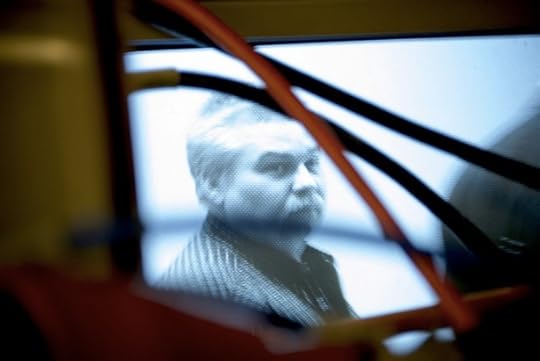Atlantic Monthly Contributors's Blog, page 271
December 18, 2015
The Sanders Campaign and Clinton's Voter Data

Updated on December 18 at 1:33 p.m. ET
The Bernie Sanders campaign came out swinging against the Democratic National Committee’s decision to suspend its access to the list of likely Democratic voters after the campaign was accused of improperly accessing Hillary Clinton’s private campaign data.
“We are announcing today if the DNC continues to hold our data hostage and continues to attack the heart and soul of our grassroots campaign, we will be in federal court this afternoon seeking immediate relief,” Jeff Weaver, Sanders’s campaign manager, said at a news conference. “What is required here is a full and independent audit of the DNC’s mishandling of this data, and its security from the beginning of this campaign to the present.”
Weaver laid the blame squarely at the hands of NGP VAN, the vendor that handles the master file, and the DNC. He said the campaign discovered a similar breach in October, segregated the data, and informed the DNC of the breach. He said the DNC assured the campaign that the problem would be fixed.
“But apparently, they are not competent in maintaining the security of data between the campaigns,” he said.
The Washington Post reported Friday that a low-level staffer viewed the information. Weaver told the Post a staffer was fired over the incident. But The New York Times reported, citing three people with direct knowledge of the breach, that four user accounts associated with Sanders’s campaign ran searches while Clinton’s data was breached. At the news conference, Weaver said the campaign was speaking to other staffers “and further disciplinary action may follow.”
The Post adds:
The DNC maintains the master list and rents it to national and state campaigns, which then add their own, proprietary information gathered by field workers and volunteers. Firewalls are supposed to prevent campaigns from viewing data gathered by their rivals.
NGP VAN, the vendor that handles the master file, said the incident occurred Wednesday while a patch was being applied to the software. The process briefly opened a window into proprietary information from other campaigns, said the company’s chief, Stu Trevelyan. He said a full audit will be conducted.
The Sanders campaign has been told it will only be granted access to the list when it provides both an explanation for what happened, as well as assurances that Clinton’s data has been destroyed, the Post added.
The suspension of access is a blow to the Sanders campaign. Clinton, the former secretary of state, is leading Sanders, the senator from Vermont, in polls for the Democratic presidential nomination. On Thursday, the Sanders campaign received the endorsement of the Communications Workers of America, a major union. The two candidates face off in the Democratic debate on Saturday.
Weaver, speaking to the Post, and the Times, citing the DNC, attributed blame for the software glitch to NGP VAN, whose chief executive called it an “isolated incident.”









The Ideology Behind the Putin-Trump Bromance

During Russian President Vladimir Putin’s marathon annual news conference on Thursday, the controversial leader heaped praise on Republican presidential frontrunner Donald Trump, calling the candidate “tremendous,” “very bright,” and “talented without any doubt.”
By Thursday evening, Trump had released an equally warm statement that would seem to belie the current state of affairs between Russia and the United States:
It is always a great honor to be so nicely complimented by a man so highly respected within his own country and beyond.
I have always felt that Russia and the United States should be able to work well with each other towards defeating terrorism and restoring world peace, not to mention trade and all of the other benefits derived from mutual respect.
Jeb Bush, Trump’s rival for the Republican presidential nomination, quickly critiqued Trump for being “flattered by praise from a despot.” But as my colleague Krishnadev Calamur noted, Trump already fancies himself as someone who could get along with “a lot of the world leaders that this country is not getting along with.”
The subtext here is, perhaps, that Trump is a strongman that other strongmen would have a beer with. Or like Putin, Trump might destroy a city and then 








Congress Ends Its Age of Austerity

The age of austerity in Washington is over.
In a series of overwhelmingly bipartisan votes, the House and Senate gave final approval on Friday to an enormous package of new spending and tax breaks that will fund the federal government for the rest of the fiscal year and add hundreds of billions of dollars to the deficit over the next decade. The $1.15 trillion omnibus appropriations bill loosens spending caps that were put in place in 2011 when concerns over the nation’s budget shortfall were paramount. And the $622 billion tax measure makes permanent dozens of popular but costly credits and deductions that help both businesses and low-income individuals and families.
While Republicans carried the tax bill to passage in the House on Thursday, the spending legislation—which totaled more than 2,000 pages—earned majority support from both parties in a 316-113 vote on Friday morning. The Senate quickly followed suit, demonstrating that a chamber famous for its dithering can act rapidly when it wants to—and never faster than when lawmakers want to catch flights home for Christmas. In a 65-33 vote after barely a word of debate, the Senate cleared both the tax and spending bills just two hours after the House vote. President Obama plans to sign the package into law.
“We began with a bill that had all of the bad stuff in and all of the good stuff out. We ended up with a bill that had all the good stuff in and most of the bad stuff out.”The year-end package was a victory for congressional leaders in both parties, who took advantage of the fading deficit concerns to pack the legislation with perks for special interests and passed it without much of the drama that has accompanied spending debates in recent years. House Speaker Paul Ryan and Senate Majority Leader Mitch McConnell secured a key policy win in the spending bill with the lifting of a 40-year-old ban on the export of U.S. oil. And they achieved a long-standing GOP goal of making permanent business-friendly tax breaks that could make it politically easier to pass a broader overhaul of the tax code in the coming years.
“This is one of the biggest steps toward a rewrite of our tax code that we’ve made in many years,” Ryan said of the tax portion. “And it will help us start a pro-growth, bold tax-reform agenda in 2016.” The spending bill, he argued, was “a big win for American jobs and the energy industry.”
Yet Democrats were equally jubilant. Party leaders bragged that while they consented to the GOP’s demand to lift the oil embargo, they beat back Republican efforts to include dozens of “poison-pill” policy provisions, such as measures to defund Planned Parenthood, suspend the Syrian refugee program, or block money for the president’s climate agenda. They championed the extension of tax credits for low-income Americans and renewable energy, along with a permanent renewal of a program granting health benefits to survivors and first responders to the 9/11 terrorist attacks. (Democrats largely ignored the fact that Republicans also succeeded in delaying provisions of Obamacare.)
“We began with a bill that had all of the bad stuff in and all of the good stuff out,” said Representative Steve Israel, a New York Democrat and member of the party leadership. “We ended up with a bill that had all the good stuff in and most of the bad stuff out. That’s the definition of victory.”
The final House vote was much less suspenseful than Nancy Pelosi, the Democratic leader, predicted it would be on Thursday, when she warned that her party had concerns and could not guarantee the votes needed to put it over the top. Democrats were particularly angry that Republicans excluded aid for debt-ridden Puerto Rico. But Pelosi won a commitment from Ryan that the House would address the problem early in the new year, and with her support, all but 18 Democrats supported the spending bill. On Friday, she conceded that she had deliberately downplayed the Democratic victories so that Republicans would not vote against the deal.
In the end, the biggest losers in the outcome were deficit hawks and conservatives opposed to large spending packages. Senator Joe Manchin, a centrist Democrat from West Virginia, decried the tax bill as leaving an “unconscionable” debt on future generations. And both Donald Trump and Ted Cruz denounced the legislation with equal fervor.









The Ugly Fight Over Arabic in Augusta County

If there was any doubt that Americans haven’t figured out a good way to grapple with Islam, look no further than Augusta County, Virginia. Schools there are closed today after an uproar over an assignment that including copying the Islamic profession of faith.
No one comes out of this looking great. The assignment at Riverheads High School near Staunton—to copy calligraphy reading “There is no god but God, and Muhammad is the prophet of God”—seems well-intentioned but ill-considered. Parents may have been justified in questioning the assignment, but the level of fury isn’t commensurate with the offense, and it’s hard to imagine it happening with any other religion. And it seems like Superintendent Eric Bond, who made the right decision in refusing to fire Cheryl LaPorte, the teacher involved, overreacted by shuttering schools on Friday, especially as there were apparently no specific threats against the system of 10,500 students. (What better evidence for a conspiracy theorist looking for Islam’s creep than the schools closing on the Muslim day of prayer?)
Related Story
The Fear of Islam in Tennessee Public Schools
It’s important not to overstate the level of backlash, a temptation that reporters and polemicists alike often indulge in stories like this. While a few parents demanded that LaPorte be fired for “violating children's religious beliefs,” others rallied around her. “Both the Virginia Department of Education and Superintendent Eric Bond have reviewed the material and found it both in line with state standards, as well as not in violation of students’ rights,” The News Leader notes. Of course, that being true, it seems a little much to shut down the schools and cancel weekend activities, just over some attention. Students and principles said that while extra security at school this week had been a little weird, the general atmosphere was fairly normal. (There’s a lesson here about students’ resiliency and calm in the face of, and as opposed to, adult hysteria.)
All that said, the assignment could have been better thought-out. It came as part of a geography-class unit on world religions, which also includes Hinduism and Buddhism. And as The News Leader points out, LaPorte didn’t come up with the assignment herself—it came from a teacher workbook, raising the question of how many times the task has been assigned without summoning a firestorm. The homework includes a printed calligraphic rendering of the phrase (known as the shahada) and asked students to copy it, to get a sense of the complexity of Arabic calligraphy.
Of all the phrases to choose, though, why this one? Using the profession of faith, an essential part of converting to Islam, feels strange, especially when there are so many other possibilities that could achieve the same task. (The phrase is also on the flags of Saudi Arabia and ISIS, among other places.) Why not bismillah al-rahman al-rahim (in the name of God, the most gracious the most merciful), a far less charged phrase? There’s no reason to believe that LaPorte was trying to indoctrinate her students into Islam, but the choice of phrase just feeds paranoia about it. It may be just another case of conservative political correctness run amok, but there’s also something uncomfortable about using someone’s expression of faith in this impersonal way. It’s hard to imagine a case in which students would be asked to recite the Apostle's Creed as part of an academic lesson on Christian liturgy.
Not that the new compromise seems great either. “Although students will continue to learn about world religions as required by the state Board of Education and the Commonwealth's Standards of Learning, a different, non-religious sample of Arabic calligraphy will be used in the future,” the district said in a statement. That’s throwing the baby out with the bathwater. Arabic calligraphy is of world-religion interest specifically because it is Islamic. Because Arabic is the language of the Qur’an, it has attained an exalted place in Islam throughout the world, well beyond Arabic-speaking countries. And because many forms of Islam prohibit or discourage figurative imagery, elaborate, beautiful, and highly stylized calligraphic artwork using Qur’anic phrases is a staple wherever Muslims are, around the world. Islamic art is a major chunk of world art, and while it’s inextricable from religion, it’s also a larger, civilizational thing than mere devotion. Using a secular Arabic phrase glosses over all that context.
Think about it this way: Would someone try to teach a class on Western art while excising Christian art as indoctrination? Of course not—in part because they’d have very little to work with in the centuries between Constantine’s conversion and the Renaissance. But Islam is something different, something that many Americans still view as a threat. My colleague Emma Green reported earlier this week on how schools in Tennessee and around the nation are facing intense efforts to roll back even the most academic, detached lessons on Islam. In many of these cases, too, the fight is being led by a small but vocal band of parents who find the act of educating about Islam, a religion with 1.6 billion followers around the world, itself objectionable and dangerous. It’s no coincidence that these battles almost always occur in heavily white, Christian school districts.
The Augusta County assignment was more vulnerable to outcry because of the unwise step of including the shahada. But there’s little question this is about fear of Islam, and not about objections to religion in the public schools. After all, Augusta County schools also offer students the chance to leave school once a week to attend Bible study.









Making a Murderer: An American Horror Story

“When I left prison, the anger left ... I was probably the happiest man on earth.” These words feel like they belong at the end of a story—as a bookend line that signals to the audience that happy endings still exist. But Making a Murderer, Netflix’s first true-crime series, isn’t that kind of show. The first of its 10 episodes introduces Steven Avery, a Wisconsin man released from prison 18 years after DNA evidence proved he didn’t commit a brutal attack. And it’s soon clear that Avery’s unbelievable story—one apparently involving gross misconduct by law enforcement—isn’t just going to end with him relishing in his newfound freedom, or fighting to make sure it never happens to anyone else again.
Because it does happen again—to Steven Avery. That’s what the writers and directors Laura Ricciardi and Moira Demos set out to prove with Making a Murderer, which was released in its entirety Friday. Two years after being released from prison, Avery was bringing a $36 million lawsuit against Manitowoc County, and the former district attorney and sheriff who helped put him away, when he became the prime suspect in a gruesome new murder investigation. The series, which explores the possibility that Avery was framed, mimics HBO’s The Jinx and the first season of the podcast Serial with its gripping, real-life case that so often feels like fiction. But Making a Murderer, which took 10 years to to make, could very well eclipse those works, for the sheer density of reportage and the scale of the horrifying story it tells—one of rural class politics, bureaucratic opacity, and a seemingly coordinated institutional effort to destroy an innocent man.
Avery, in prison since 2005 for the murder of the 25-year-old photographer Teresa Halbach, attracted the directors’ attention when they realized how unprecedented his case was. Why would a man who was exonerated by DNA evidence—essentially an Innocence Project poster boy—get out only to then commit a heinous rape and murder? Making a Murderer digs into Avery’s past, his family, and mountains of evidence, asking, did the injustice he suffered make him into a murderer? Or did the officials threatened by Avery’s suit take it upon themselves to make him into one in the eyes of the law? Making a Murderer decides early on to hedge its bets on the latter being true and makes its case convincingly. (Disclosure: I interviewed Ricciardi and Demos for a podcast about the series sponsored by Netflix.)
Making a Murderer, which took 10 years to to make, could very well eclipse The Jinx and Serial.The series isn’t solely focused on proving Avery’s innocence, though. It takes its time painting a broader portrait of the people waiting for him on the outside: his fiancee, his children, and especially his mother and father. For even the skeptical viewer, it’s hard not to feel a stab of empathy when Avery’s elderly mother pulls out boxes of legal documents she sent to shows including 20/20 in the hope they’d cover her son’s story. (And then, two episodes later, not to feel angry when a Dateline producer raves about covering Avery’s latest arrest, saying, “Right now, murder is hot.”) Since Demos and Ricciardi lived in the Averys’ town for two years, there’s a palpable intimacy between their subjects and the camera.
The series differs in a few main ways from its most popular contemporaries. It lacks the stylishness of The Jinx: For example, the credit sequence doesn’t feature reenactments of gunshots or bodies being disposed, nor is the series divided into titled “chapters.” And it doesn’t insert its creators into the story: Demos and Ricciardi remain out of sight and earshot, whereas The Jinx’s Andrew Jarecki and Serial’s Sarah Koenig felt somewhat central to their respective narratives. Making a Murderer, meanwhile, feels more journalistic. It unfolds strictly through surveillance footage, phone recordings, legal documents, news reports, press conferences, crime-scene photos, one-on-one interviews, and the occasional aerial shot of a snow-blanketed salvage yard. (The series was funded on a shoestring budget, with grants cobbled together over the years.)
What it lacks in terms of sensationalism and gloss, it makes up for by possessing that very quality every Netflix show aspires to have: bingeability. The series begins slowly, but after grasping enough names and faces, you start feeling a sense of total immersion (one best exemplified, perhaps, by first-season Serial fans’ obsessive chatter about cellphone towers or Leakin Park). But the documentary’s relatively no-frills approach, and its resistance to offering easy answers, makes speeding through each episode feel less troubling on an ethical level. You never quite feel that you’re too eagerly consuming someone else’s tragedy; each revelation or twist brings enough frustration or disbelief to balance any feeling of exhilaration. Making a Murderer has the potential to be as popular and thought-provoking as its forebears—and to have real-life repercussions.









Sisters Are Doing It for Themselves

I had a nightmare the other night. It went like this: The friendship between Tina Fey and Amy Poehler—the one that began in Chicago when the two were struggling comics, the one that has been the subject of glowing journalistic profiles, the one that has popularized the unironic use of the phrase “platonic life partners”—turned out to be fake. The relationship that celebrates mutual admiration and respect, that revels in girl power, that has by cultural osmosis done extremely good things even for women who do not happen to be Amy Poehler or Tina Fey—was, in reality, a PR scam. The “friendship” was ginned up to sell movies and books. Tina and Amy don’t even talk.
It was a Real Housewife-level deception. It was awful.
Related Story
Why Do So Many Pretty Female Comedians Pretend They're Ugly?
Fortunately (I think/hope/need to believe), it was only a dream. The friendship between Tina and Amy—though “friendship” doesn’t feel sufficient as a description of the cosmic entity that is their union—is real. And it’s more than a friendship. It’s more even than a creative force, the first mover behind so much recent Hollywood comedy. It’s a friendship with a market value ($72,000 for one night of it, according to the results of a 2012 auction), sure, but more than that it is an agent of good in the world—one of those warm, bright things whose sheer existence makes everything seem like it’s going to be okay. The Fey/Poehler partnership has, at this point, become its own kind of celebrity—the star of, among so much else, comedy sketches and awards shows and magazine articles and TV shows and books and movies.
The latest of those movies is Sisters. The film, written by longtime Saturday Night Live writer Paula Pell and directed by Pitch Perfect’s Jason Moore, casts the pair as, yes, sisters—the older one wild, the younger one prudish. (In an inversion of the Baby Mama dynamic, it’s Fey—refreshingly out of Liz Lemon/Kate Holbrook/Portia Nathan mode—who plays the leopard-print wearer, and Poehler who buttons up.) Kate Ellis (Fey) is an aesthetician who has trouble holding down a job (she has an inconvenient tendency to get distracted and burn off her clients’ eyebrows). She’s also a single mom with a teenage daughter who says stern things like, “I love you, but your life is too chaotic right now.” Maura (Poehler), a nurse who is coming off of a divorce, fills her free time with charity work that seems mostly to involve handing out inspirational-message cards to the homeless (“Without the dark, we would never see the bright stars”).
It’s a friendship with a market value ($72,000 for one night of it, according to the results of a 2012 auction), but it is actually, pretty much, priceless.Despite their differences, the Ellis sisters love each other. They have one of those bonds only sisters can understand. But they live, as so often happens these days, apart—in different cities, and more broadly in different places. While they’re happy, and at home, when they’re together, each sister’s life is also, as Tolstoy might have put it had Tolstoy lived in 2015, shitty in its own way.
Things change, though, when the sisters’ parents (James Brolin and Dianne Wiest) announce that they’re selling the house they grew up in, in Orlando, to move to a nearby “adult community.” Visiting one last time to pack up their old bedroom (the contents of which include the delightful detritus of late-’80s teenagerhoods: Thighmasters, lava lamps, Cabbage Patch kids, Jane Fonda aerobics videos, Care Bears t-shirts, Dep hair gel, a Michael J. Fox poster), the sisters make a decision: They’ll have one last night in the house together before ceding it to the snooty New Yorkers who are planning to purchase it. They decide—shitty lives, nostalgia, Jane Fonda—to throw a party. Not just the wine-and-cheese-and-if-things-get-crazy-maybe-some-Scattergories kind of thing that society would suggest is appropriate for 40-somethings, but a high school-style rager. With all the booze and drugs and sex that come with it.
The sisters take to Facebook to see who of their old high school classmates is around. They spread the word. They go to Big Lots for supplies.
‘They adore each other. They’re like sisters. They’re like Scottie and Westie puppies in a basket.’Spoiler: Things go terribly awry! Everything gets out of hand! People get injured! Cops get called (twice)! An old frenemy shows up with plans to get the whole party shut down! A tree is felled! A love interest of Maura’s (the charming Ike Barinholtz, refreshingly out of Morgan Tookers-from-The Mindy Project mode) gets a rotating ballerina music box wedged in an extremely awkward place!
Is Sisters a good movie? No. No, it is not. Its plot manages to be both jarring (so many twists!) and predictable; its supporting characters are thin; it makes gleeful use of tired stereotypes (butch lesbians! put-upon mothers who Just Want to Let Loose! Asian nail technicians who go from meek to chic with the help of some sequined miniskirts!). Sisters is, like so many products of Hollywood these days, a wacky project that seems to have been created mostly so its stars can have an excuse to hang out with each other. Those stars, in this case, include Maya Rudolph and Rachel Dratch and John Cena and John Leguizamo and Kate McKinnon and Samantha Bee and Jon Glaser and Renee Elise Goldberry and Bobby Moynihan—and they all act, indeed, like they are having a ton of fun.
Mostly, though, the hanging in question is done by Fey and Poehler. Sisters reads like a Baby Mama reunion, its preoccupation with babies shifting to a preoccupation with parenthood more generally. (“Now everyone get out of here,” Mr. Ellis yells as he encounters the party, “or I’ll call your kids!”) This time, though, the enjoyment Fey and Poehler take in each other is the star of the show. They get to be wacky. They get to be improv-y. They get to be sisterly. “Oh my God, I’ve never had so much fun working with anybody as with those two,” is how Holland Taylor described working with the pair on the set of Baby Mama. She added: “They adore each other. They’re like sisters. They’re like Scottie and Westie puppies in a basket.”
But that’s the thing. They’re like puppies! They’re like actual sisters! The love and admiration and whimsy and fun they have for and with each other pops off of the screen whenever they share it. Their friendship is the star here. It’s the whole point. It steals the spotlight when, as the Ellis sisters, Fey and Poehler are goofing around, trying on their old clothes. And when they’re reading passages from their old diaries to each other. And when they’re making jokes about their age (Maura, shopping with Kate for a party outfit: “We need a little less Forever 21, and a little more Suddenly 42”). And when they’re doing a choreographed dance to Snow’s “Informer.”
And it steals the spotlight again during the gag reel that comes, inevitably and gloriously, at the end of the movie. Here’s more of Poehler and Fey, as Maura and Kate but also as themselves, cracking each other up. The reel may well be the highlight of the movie. Which is telling. But also: It’s more of Tina and Amy, and also more of that biggest and brightest of Hollywood stars: their friendship. And the more we get of that, however it comes, the better.









He’ll Take the Low Road: Trump’s Tortured History With Scotland

Donald Trump is a man without a country. The Queens neighborhood where he grew up has changed radically, and is now home to some of the Muslims he disparages. In New York, a left-leaning city and state, his presidential run is met with derision and embarrassment.
And then there’s Scotland. Trump has long sought Alban affection, only to be met—in large part—with a Caledonian cold shoulder. From the Borders to the Hebrides, Trump has sought to emphasize his ties with Scotland; in return, he’s earned loathing in Midlothian and antipathy in Ayrshire. The latest blow came this week, when the U.K. Supreme Court rejected his efforts to block the installation of wind turbines off the coast of Aberdeen, which Trump argued would sully Scotland’s pristine beauty—and the view from his golf development.
It’s the latest in a series of recent slights, including losing his status as an honorary ambassador for Scottish business and being stripped of an honorary degree from Robert Gordon University in Aberdeen. Trump lashed out at the decision, accusing the Scottish government of a “foolish, small-minded, and parochial mentality.” But he hasn’t always felt that way, and has long courted Scots. The tale begins with Trump’s mother.
Related Story
The Ethics of Barring Donald Trump From Your Country
Mary Anne MacLeod was born in Tong, a tiny village (2001 population: 527) on the Isle of Lewis in the Outer Hebrides, off Scotland’s West Coast. Her parents spoke Gaelic; the remote town offered a hardscrabble life. In 1930, she left for New York, where she met and married Fred Trump, a successful real-estate developer. In 2008, Donald Trump visited Lewis for the first time in decades, stopping by the cottage where his mother was born (for 97 seconds, according to The Guardian’s count).
“I feel very comfortable here,” he said. “It’s interesting when your mother, who was such a terrific woman, comes from a specific location, you tend to like that location. I think I do feel Scottish.”
Trump had an ulterior motive for these warm words. He was en route to Aberdeen, on the east coast, where he was seeking approval to develop a huge golf course. “I think this land is special, I think Scotland is special, and I wanted to do something special for my mother,” he said.
Trump had bought a portion of the Menie Estate in Aberdeenshire two years earlier with the intention of building a golf course and resort there. But the area included sand dunes that were a protected site. He was eventually able to win approval—over the reservations of local residents and government—and construct the course. Ultimately, Scottish officials decided the economic benefit outweighed the environmental degradation. That didn’t stop Trump from whining throughout the process that the government was going hard on him despite his plans to invest vast amounts of money in the country. “If somebody else had applied, they would have gotten it a lot easier than me,” he said. “The celebrity and all of this media and craziness is probably a liability for me. But it’s an asset for the area and for Scotland. Everybody is talking about this course all over the world.”
The course opened in 2012; it is, according to its website, “the world’s greatest golf course.” But Trump’s approach had sowed animosity among locals. As The Scotsman noted, “People didn’t take kindly to a billionaire American jetting in to a rural corner of Scotland, making disparaging remarks about a collection of buildings on a hillside that didn’t fit with his idea of an upmarket golf resort.” A critically acclaimed documentary, You’ve Been Trumped, told the story of how he’d managed to railroad through the course.
Almost immediately, Trump was engaged in a fight over the wind farm. In 2012, he fired off a characteristically Trumpian letter to First Minister Alex Salmond, the head of the Scottish government. “With the reckless installation of these monsters, you will single-handedly have done more damage to Scotland than virtually any event in Scottish history,” he thundered. “As a matter of fact, I have just authorized my staff to allocate a substantial amount of money to launch an international campaign to fight your plan to surround Scotland’s coast with many thousands of wind turbines.”
With typical humility, he told Salmond, “Please understand that I am doing this to save Scotland.”
“I think this land is special, I think Scotland is special, and I wanted to do something special for my mother.”That was, one might say, a wee bit daft. “It’s hard to think of a less sympathetic character in the eyes of most Scots. Despite all his tartanry and trumpeting of heritage, The Donald is almost the anti-Scot personified,” wrote Lesley Riddoch. “Left and right, unionist and nationalist, man and woman, young and old—it takes quite a lot to unite the people of this notoriously fractious little country in a collective shudder.”
The fight soon turned even nastier. It emerged that a Salmond aide had written to Trump in 2009, asking the businessman to back the release from prison, on compassionate grounds, of Abdelbaset al-Megrahi, the Libyan convicted in the 1988 Lockerbie bombing over Scotland. The release was not popular in Scotland or the United Kingdom. Trump’s son Donald Jr. gleefully blasted Salmond, claiming that the first minister was backing the wind farm as retribution for Trump declining the request.
“He asked us to support his decision to release a terrorist that killed hundreds of people. Ever since we refused to do that, he has been a total enemy of ours,” Donald Jr. told The Scotsman. “From that point on, all of the promises that we were made about the [wind farm] application changed drastically.”
But Trump’s gnashing of teeth about the supposed environmental damage from the wind farm rang rather hollow, given that his resort had been built on theretofore-protected dunes. Meanwhile, it was becoming clear that the 6,000 jobs he’d promised as part of the project weren’t about to materialize—there were just 200 by the summer of 2013.
Having lost the fight over the wind farm at a lower level, Trump announced in February 2014 he was taking his toys and going—well, not home, but to Ireland. But he also said he would appeal the wind-farm decision. In the meantime, he vowed to keep the Aberdeen course open, even as he halted plans for a second course on the site. “We have a spectacular piece of land for the second course and we look forward to getting on with the project,” he said, “but I can’t do that in all good conscience when the threat of very ugly industrial turbines looms over Aberdeen.”
Two months later, however, Trump bought Turnberry, a golf resort in Ayrshire, in southwest Scotland. And in July, he insisted that he liked Alex Salmond. He declined to take a stand on a referendum on Scottish independence—Salmond’s life’s work—saying the outcome would have no impact on his development plans. Yet when the referendum failed in the fall, Trump wasted no time stabbing Salmond in the back. “Had he not littered Scotland with these horrible wind turbines, which have raised everybody’s taxes … I think he would have done much better,” Trump told Fortune. But he also added, “Scotland is the most magnificent land there is.”
Then came Trump’s presidential campaign, and its long string of variously outlandish statements. There was the honorary degree taken away, along with the business ambassadorship. Hundreds of thousands of Britons signed a petition calling for Trump to be barred from the U.K. Golf officials reportedly decided not to play the 2020 British Open at Turnberry. Trump lashed out, feelings hurt and feeling unappreciated.
“I have done so much for Scotland, including building Trump International Golf Links, Scotland, which has received the highest accolades, and is what many believe to be one of the greatest golf courses anywhere in the world,” he wrote in an op-ed. “The UK politicians should be thanking me instead of pandering to political correctness.”
And then, finally, came the repudiation at the U.K. Supreme Court. Trump has again vowed to appeal to a European court, but the odds of a victory are vanishing toward nothing. Salmond, who resigned his leadership of the Scottish National Party and the first ministership after Scotland’s independence referendum, got a chance for sweet revenge, branding Trump “three times a loser.”
“Despite all his tartanry and trumpeting of heritage, The Donald is almost the anti-Scot personified.”What went wrong in Trump’s relationship with his mother’s homeland? The Donald has built his incredible rise in U.S politics by courting a political constituency that feels ignored by politicians. In Scotland, acting as a businessman, he adopted a much more traditional approach: He assiduously worked to win over powerful national leaders, whether in the Labour Party or the Scottish National Party. That worked for a while—for example, it helped him overcome the resistance of local Aberdeenshire officials to his golf development. In the long run, however, his act wore thin. His bombast alienated Salmond and other government officials, and it never won over many ordinary Scots.
Trump seems to have believed that his nostalgia for his mother’s homeland—newly felt when he needed approval for his golf courses—would win over Scottish hearts. “I don’t feel like an interloper,” he once said. “I don’t feel that people see me as an outsider.” He seems to have been wrong. Scots aren’t in desperate need of another rich American with a seemingly superficial desire to connect with his roots. Such Americans are easy to find—scarfing haggis, neeps, and tatties on the Royal Mile, or standing on a street corner in St. Andrews, sporting ill-fitting tartan golf gear. Trump may have been wealthier than the rest, but he was also louder, ruder, and less endearing.
It’s a painful reality for a man who says he just wanted to honor his mother, for which there might be no better remedy than a few drams of a fine single malt. Alas, Trump is a teetotaler.









‘O Holy Night’: A Call to Fall to Your Knees

Welcome to The 12 Days of Christmas Songs: an attempt to uncover the forgotten history of some of the most memorable festive tunes. From December 14 through 25, we’ll be tackling one secular song and one holy song each day.
Knee metaphors are for humans at our humblest: Fall on your knees. Know your smallness in the universe.
Sometimes, this act of falling is a response to tragedy or cruelty. But sometimes, it is awe. These are the knees of “O Holy Night”: wonderstruck, joyous, and yes, a little wobbly. Fall on your knees, the song commands. Jesus has been born, and even the angels are singing. A thrill of hope; the weary soul rejoices. For yonder breaks a new and glorious morn. This is no normal night. It’s a time to brace, to get close to the ground. Oh, night divine.
The 12 Days of Christmas Songs Reflections on the music of the season, both secular and sacredRead more
It’s this physicality that makes “O Holy Night” so fascinating. The imagery of the song is powerful: the stars brightly shine, the very world lays “in sin and error pining.” It’s easy to imagine the dark, dark Bethlehem night, a stunning planetarium sky. Amid all this poetry, what do humans do, according to the song? They lower themselves, trying to find a bit more stability. This reaction seems right. It’s a posture of openness, rather than knowing, because on that night, who could have guessed what was to come?
Often, this humility is lost in the singing. I mentally associate “O Holy Night” with sopranos like Céline Dion and Whitney Houston, who dramatically trill the song to unbelievable heights, a full orchestra behind them. It’s also been Josh Groban-ized, lyrically transformed into a full-blown Hallmark movie climax. These renditions are impressive, and they have been popular. But the singers are not on their knees. They make the song less by performing it as more than what it is: a divine gutpunch, a breathless celebration of a world fundamentally changed.
In 1855, the American Unitarian minister and music critic John Sullivan Dwight translated the song from its original French, which had been composed a few years earlier. The first version referred to “kneeling people,” but Dwight gave the knees greater prominence, translating the line Peuple à genoux, attends ta délivrance as a more urgent call to supplication. Like many of his contemporaries in Boston, Dwight was a transcendentalist, so perhaps he would disagree with a read of the song as an ode to sin. To him, music was less about vulnerability and emotion than intellectual stimulation; as he wrote in a November 1870 essay for what was then The Atlantic Monthly:
The truest feeling, such as true art, true music breathes and makes appeal to, is of a more intellectual temper. Heart quickens brain; then thought reacts on feeling, and carries it up to a sense of perfect order, to a holy love and yearning after unity.
A yearning for unity: It’s not quite praise of brokenness. But at the very least, it seems like a subtle nod to the power of music to make us feel humble.
More than 150 years later, at least one artist has captured this feeling. There are many reasons to adore Sufjan Stevens’s Christmas album, but his version of “O Holy Night” is among the foremost. Stevens is an atypical Christian music maker: He often sings about God, even when it isn’t Christmas, but he never seems preachy. He seems fragile. He seems like he needs Jesus’s love.
Savor the insistent plucking of the banjo, the slightly-out-of-tune male-and-female chorus, the high notes not quite hit! The awkward recorder interlude is a Sufjan signature, and it’s fitting here: What are recorders if not the frailest of wind instruments? And then there’s that line. Fall on your knees, Sufjan crows, weaving in and out of the vowels. Stop performing; listen. Hear the angel voices.
People don’t often declare whole nights divine, except in a passing, literary way. The holiness of that night in Bethlehem was not literary, but literal; it was magical, and full of promise. It’s comforting to think that someone like Sufjan, so thoroughly contemporary and of our time, knows what to do in the event of a holy night. Everyone’s knees could use some practice.









December 17, 2015
The First Criminal Charges in the San Bernardino Shooting

Federal prosecutors arrested on Thursday a friend of one of the San Bernardino shooters who investigators say purchased assault weapons that were used in the deadly attack this month.
The FBI arrested Enrique Marquez, 24, a longtime friend and former neighbor of Syed Rizwan Farook, the man who, along with his wife, Tashfeen Malik, killed 14 people and wounded 21 others in a shooting rampage at his office holiday party in California earlier this month, the Associated Press and several other news organizations reported.
Marquez has been charged with providing material support for crimes of terrorism, conspiring with Farook to commit terrorist attacks in 2011 and 2012 that were never carried out, and other crimes. Prosecutors say Farook radicalized Marquez, who converted to Islam, according to The New York Times. Authorities believe Marquez purchased two assault rifles as a favor to Farook, who would then not have to go on record as the buyer and undergo a background check, according to NBC News.
Marquez, who was not directly involved in the San Bernardino shooting, is the first person to be charged in connection with the assault.
Federal officials determined soon after the attack the shooters were inspired by foreign terrorist organizations. The Islamic State praised the assault, calling Farook and Malik “followers,” but did not claim responsibility for organizing it, as it had done in Paris last month.
In the days after the shooting, one question emerged: Did U.S. intelligence miss warning signs about Farook and Malik. Farook was born in Illinois and had worked for the San Bernardino County’s public health department as an inspector for five years. Malik was born in Pakistan and arrived in the U.S. last year on a fiancee visa to marry Farook, whom she’d met on a dating website for Muslims. The couple had a six-month-old child, and lived in a quiet neighborhood not far from where the shooting occurred.
But while Farook and Malik had spoken of jihad online several years ago, even before they began dating, “those communications are private direct messages,” said the FBI’s director, James Comey, on Wednesday. The messages were also general in nature, and not about specific plots. Comey’s remarks appeared to refute news reports that Malik had pledged allegiance to the Islamic State in a public Facebook post the morning of the assault, which Facebook had reportedly confirmed. As my colleague David Graham wrote Thursday, “the fact that the messages in question were private, beyond the reasonable ken of law enforcement and well past constitutional limitations, is yet another indication of the steep challenge American officials face in trying to stop homegrown attackers who are inspired by ISIS or other terrorist groups but appear to be acting largely autonomously, without instruction from known terrorist leaders.”
President Obama recently pointed to the difficulty of uncovering and preventing homegrown jihadist terrorist plots. “As groups like ISIL grew stronger amidst the chaos of war in Iraq and then Syria, and as the Internet erases the distance between countries, we see growing efforts by terrorists to poison the minds of people like the Boston Marathon bombers and the San Bernardino killers,” he said.
Funerals for the shooting victims were held this week. Obama will travel to San Bernardino on Friday to meet privately with the families of the victims.









Who Is 'Pharma Bro'?

The arrival of Martin Shkreli into the discourse of 2015 has had all the hallmarks of a super-moon or some other semi-rare phenomenon requiring the perfect alignment of nature’s forces.
Shkreli, duly dubbed “Pharma Bro” by the media, is the perfect and very hateable combination of arrogance, youth, and avarice. He has our attention because his work as a pharmaceutical executive holds in contrast against his clients—people who are often sick, poor, and vulnerable.
In September, Shkreli raised the price of a life-saving drug from $13.50 to $750 and spent $2 million to buy the only copy of a Wu-Tang Clan album. Writing in The Atlantic in September, James Hamblin called him “the face of unapologetic profiteering from the suffering of humans.”
Shkreli was arrested on Thursday on securities-fraud charges. Earlier this week, Daisy Hernández wrote in The Atlantic that Shkreli had a new gambit that would raise the price of a drug used to a treat Chagas, a disease mostly affecting Latin American immigrants. “Chagas is a disease of the poor,” said an adviser for Doctors Without Borders, “so it’s not a disease where people have access if prices are high.”
This latest scheme seems revelatory given the biography of this 32-year-old executive. According to Bloomberg, he's from a working-class neighborhood in Brooklyn and the son of Albanian and Croatian immigrants who worked as janitors. “He dropped out of high school and cut his teeth as an intern on Jim Cramer’s CNBC show Mad Money,” wrote Victor Luckerson at Time. “Later, he started a pair of hedge funds, Elea Capital and MSMB Capital.”
Elea met its demise when, as The New York Times reported, Shkreli wagered $2.6 million that the stock market would decline in 2007. He was ultimately right, but it spiraled too late.
“I learned a lot about using leverage, the perils of leverage,” Shkreli, a chess and guitar fanatic, said at the time. “Back then, this was almost 10 years ago, I was rushing to succeed. I made a monster bet that the market would crash, and I was wrong.”
When hedge funds didn’t make him wealthy, he entered the world of pharmaceutical drugs, where his practices made him a well-known public figure whose name now rings out from congressional hearings and beyond.
Shkreli seems to relish the spotlight. On Wednesday, just hours before he was arrested, he made more headlines by offering to bail out jailed rapper Bobby Shmurda, said he would let Taylor Swift listen to his Wu-Tang album in exchange for a sexual favor, and has aspirations to take over the hip-hop world. He didn’t stop there:
That’s my real life. I fucking travel around [Las Vegas] with fucking $2 million or $3 million in cash like Floyd Mayweather. It’s real. Whether you think I’m a herb or whatever, fine. But I’m the dude. I’m the guy. I’m not made up. Take it for what it’s worth. If you think that’s not going to do anything... 80 guys have tried to turn DMX’s career around. It’s never gonna happen, but I love that dude.









Atlantic Monthly Contributors's Blog
- Atlantic Monthly Contributors's profile
- 1 follower



